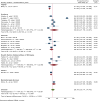Sexual and reproductive health service utilization and associated factors among high school students in Ethiopia: systematic review and meta-analysis
- PMID: 39360034
- PMCID: PMC11445232
- DOI: 10.3389/frph.2024.1361662
Sexual and reproductive health service utilization and associated factors among high school students in Ethiopia: systematic review and meta-analysis
Abstract
Introduction: Several studies have been done on the utilization of sexual and reproductive health services by high school students in Ethiopia, but they have yielded inconsistent results. This study aimed to evaluate the extent to which high school students in Ethiopia are using sexual and reproductive health services by conducting a systematic review and meta-analysis.
Methods: Various electronic databases such as PubMed, Cochrane Library, AJOL, Google Scholar, and Grey Literature were used to search for relevant articles. Preferred Reporting Items for Systematic Reviews and Meta-Analysis Guidelines were followed for this review and meta-analysis. Heterogeneity was assessed using I2 and Cochrane Q statistical tests, and data analysis was done with STATA 17 software. Random effect meta-analyses were used to determine the overall utilization rate of sexual and reproductive health services.
Result: This review included 20 studies with 12, 215 study participants. The pooled magnitude of sexual and reproductive health service utilization among high school students in Ethiopia was 29.79% (95% CI: 25.14, 34.43). Students with grades 11-12 (AOR = 2.33, 95% CI: 1.39, 3.90), aged between 20 and 24 years (AOR = 2.61; 95% CI: 1.79-3.81), having higher level of knowledge towards sexual and reproductive health issues (AOR = 3.10; 95% CI: 1.67-5.77), previous history of sexual intercourse (AOR = 4.18; 95% CI: 2.59-6.75), previous history of sexually transmitted infection (AOR = 3.74; 95% CI: 2.22-6.31), presence of a reproductive health service facility in the school (AOR = 2.55; 95% CI: 1.72-3.77), and ever-discussed reproductive health issues (AOR = 4.04; 95% CI: 1.62-10.03) were more likely to utilize sexual and reproductive health services.
Conclusions: The overall utilization of sexual and reproductive services among high school students in Ethiopia was found to be low as compared to SDG 3.7. Older individuals with higher education levels and knowledge about sexual and reproductive health services, as well as those who have had previous sexual experiences or discussions about sexual health, are more likely to utilize reproductive health services. To increase utilization, the Ministry of Health and the Ministry of Education should prioritize these factors.
Keywords: Ethiopia; high school; meta-analysis; sexual and reproductive health; students; utilization.
© 2024 Delie, Adal, Tareke, Ketema Bogale, Anagaw, Tiruneh, Fenta and Endeshaw.
Conflict of interest statement
The authors declare that the research was conducted in the absence of any commercial or financial relationships that could be construed as a potential conflict of interest. The reviewer MM declared a shared affiliation with the author MGT to the handling editor at the time of review.
Figures













Similar articles
-
Prevalence and associated factors of early initiation of sexual intercourse among youth in Ethiopia: systematic review and meta-analysis.BMC Public Health. 2023 Oct 23;23(1):2072. doi: 10.1186/s12889-023-16968-y. BMC Public Health. 2023. PMID: 37872488 Free PMC article.
-
Sexual and reproductive health services utilization and associated factors among secondary school students in Nekemte town, Ethiopia.Reprod Health. 2018 Apr 17;15(1):64. doi: 10.1186/s12978-018-0501-z. Reprod Health. 2018. PMID: 29665831 Free PMC article.
-
Utilization of Reproductive Health Services and Associated Factors among Secondary School Students in Woldia Town, Northeast Ethiopia.J Environ Public Health. 2021 Apr 20;2021:2917874. doi: 10.1155/2021/2917874. eCollection 2021. J Environ Public Health. 2021. PMID: 33986811 Free PMC article.
-
Sexual and reproductive health services utilization and associated factors among adolescents attending secondary schools.Reprod Health. 2022 Jul 15;19(1):161. doi: 10.1186/s12978-022-01468-w. Reprod Health. 2022. PMID: 35840973 Free PMC article.
-
Magnitude of Sexual and Reproductive Health Service Utilization Among Youths and Adolescents Living With Disability in Ethiopia: A Systematic Review and Meta-Analysis.Health Sci Rep. 2025 Mar 20;8(3):e70573. doi: 10.1002/hsr2.70573. eCollection 2025 Mar. Health Sci Rep. 2025. PMID: 40124924 Free PMC article. Review.
References
-
- WHO. Adolescent health in the South-East Asia Region. (2021). Available online at: https://www.who.int/southeastasia/health-topics/adolescent-health (Accessed November 17, 2023).
-
- UNICEF D. UNICEF Data: Monitoring the Situation of Children and Women. New York, NY: Unicef; (2016).
-
- Population, total - Sub-Saharan Africa. (2017). Available online at: https://data.worldbank.org/indicator/SP.POP.TOTL?locations=ZG (Accessed November 21, 2023).
Publication types
LinkOut - more resources
Full Text Sources

